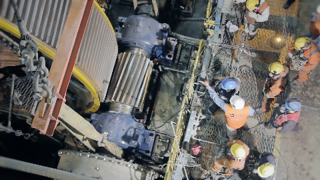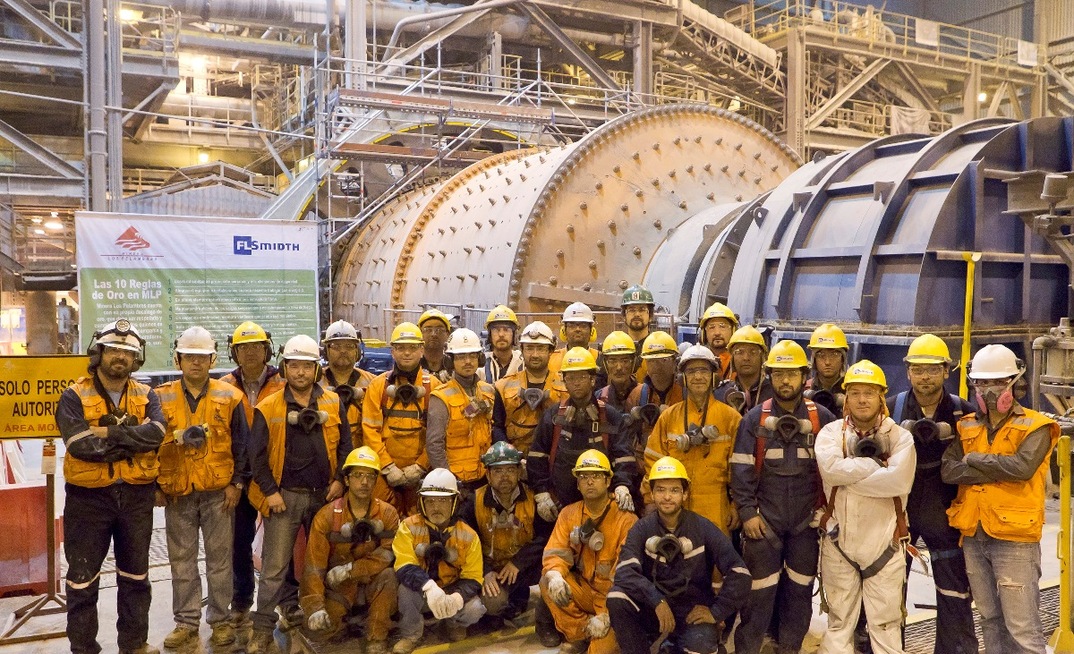In the Andean Cordillera, in the Chilean district of Salamanca, Coquimbo Región, lies one of the world's biggest copper deposits: Los Pelambres. Situated 3,100m above sea level, the mine is the daily workplace for more than 5,000 people.
When the deposit was discovered in 1920, the flat part of the site was no bigger than a football field, so when FLSmidth supplied the concentrator in 1999, much of the hillside had to be carved away.
Today, a primary gyratory crusher and an overland conveyor system transport run-of-mine ore 13km to the stockpile at the concentrator, which is situated downhill at 1,600m above sea level. Here, two large semi-autogenous grinding (SAG) mills and two pebble crushers work with four large ball mills, feeding the concentrator with about 170,000t/d of ore.
The thickeners, some of the largest in the industry at 125m-diameter, enable the recirculation of more than half of the water used in the process. Fresh water is drawn from local rivers, and a further kilometre down the hillside, water is discharged and the tailings are disposed of at the El Mauro tailings dam.
Building trust
At first glance, Los Pelambres looks like any other copper mine. Still, it is distinctly different, because for every Los Pelambres employee on site there are five contractor employees. When the operation began in 2000, Los Pelambres and FLSmidth formed a strategic alliance for the maintenance of the concentrator – an industry first at the time.
Outsourced maintenance contracts often only run for a few years to ensure the best price. However, the FLSmidth team has managed to keep the contract for 17 years now.

"By increasing the scope of our responsibility, we have at the same time managed to continue to lower the cost more than 10% over the years," said Francisco González, FLSmidth’s director of maintenance services in Chile with responsibility for the 250 FLSmidth personnel on site. "And the continuity has allowed us to reduce the number of parts required, minimise points of failure and provide continuity of employment of personnel."
As a tier-one supplier, Antofagasta Minerals has given the FLSmidth team full responsibility for the maintenance planning and supply of parts and, according to González, that is key to the team’s strong performance.
"Very often the customer has the overall responsibility for scheduling shutdowns and ensuring parts supply, but at Los Pelambres, our teams are responsible for the performance of the entire process and the maintenance budget. We propose maintenance improvements, we order specialist engineers or spare parts and we schedule the maintenance. This also means that we constantly educate our team to guarantee operational excellence," he said.
This responsibility enables the team to do root cause analysis and run a condition-based operation taking calculated risk into account.
"We know when repairs and maintenance are urgent, and when a fault can be monitored or addressed during planned shut downs at a later date,” explained González. “The cost in lost profit for every hour of shutdown makes it crucial to know the correlation between reduced operation and prolonged maintenance."
Reaping the benefits

The long relationship has enabled Los Pelambres to achieve an impressive 90% recovery rate and 92% availability at the concentrator, as well as make continuous process improvements.
"By modifying the design of the pump pipeline to the cyclones, we reduced the number of joints and unifying parts. That resulted in an increase in the lifetime of piping parts to cyclones, doubled the hours of operation and enhanced system reliability, and reduced costs resulting from the breakage of parts and simplified the changeover components," González explained.
By tweaking the SAG mill design to improve discharge end configuration, the team reduced the number of parts required by 30%, and the streamlining of maintenance increased mill availability with double digits. By using lighter materials, such as rubber-ceramic pulp lifters, the team also increased power available for grinding which boosted production capacity.
The close relationship with the Antofagasta Minerals team has even enabled co-development projects; The Wemco 250m3 flotation cells were developed by FLSmidth together with the Antofagasta Minerals team, and Los Pelambres was the first mine in the world to benefit from the design.
Scheduled shutdownsMajor maintenance at Los Pelambres is conditional on the relining of equipment such as the SAG and ball mills, which require the plant to close down completely. Six months before shutdown, the team begin ordering the critical equipment parts needed. "Coated components, especially, have a long lead time,” said González. “With thousands of units and, on average, 2,500t of coatings, the parts planning is almost as complex as ensuring that the extra 500 personnel we bring in are fully in position to carry out all activities planned." A week before the major shutdown, the team places parts and equipment at key work area locations, and conducts an internal audit to review the process for all critical activities. When the operation has succeeded and the plant is up and running again, the FLSmidth team writes an evaluation report to ensure continuous improvement in future activities.
|
























